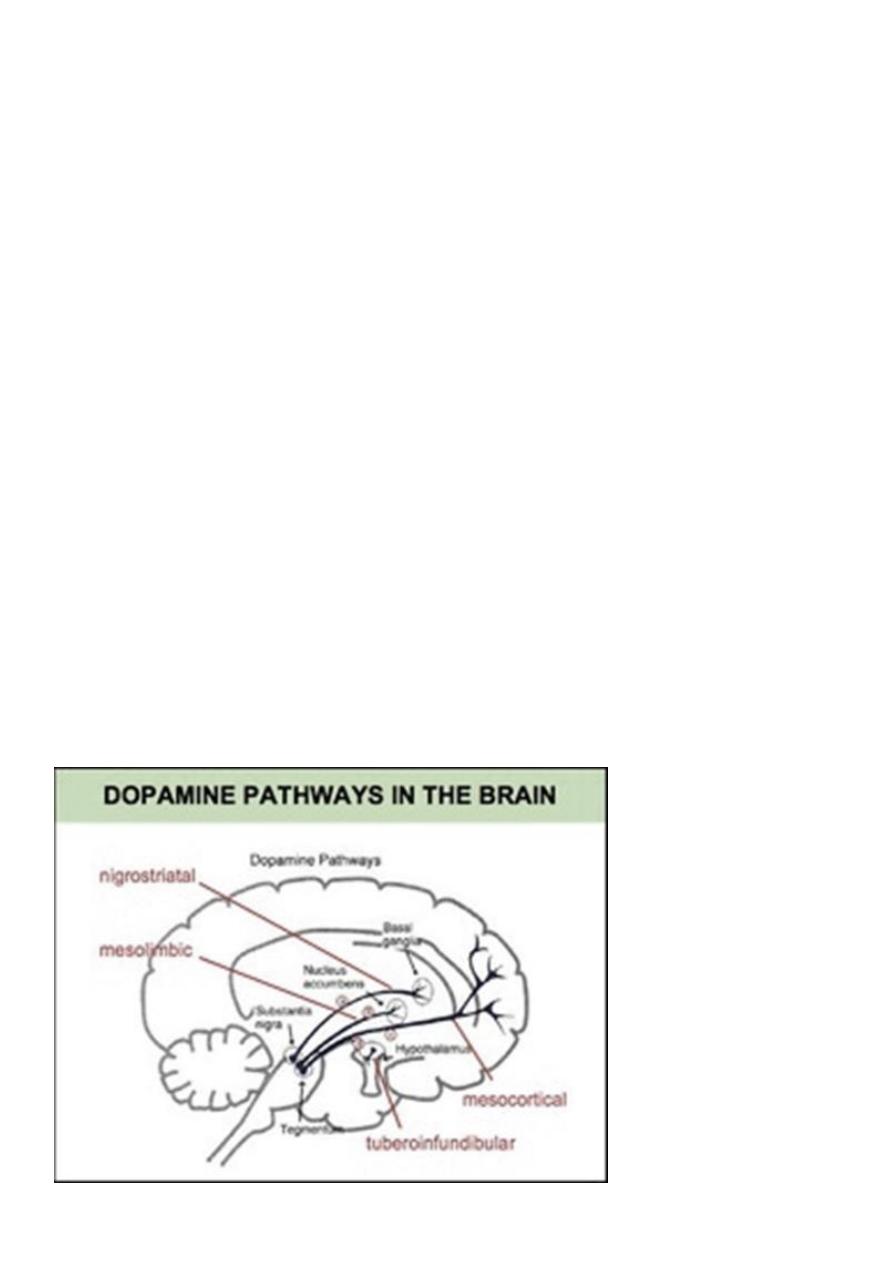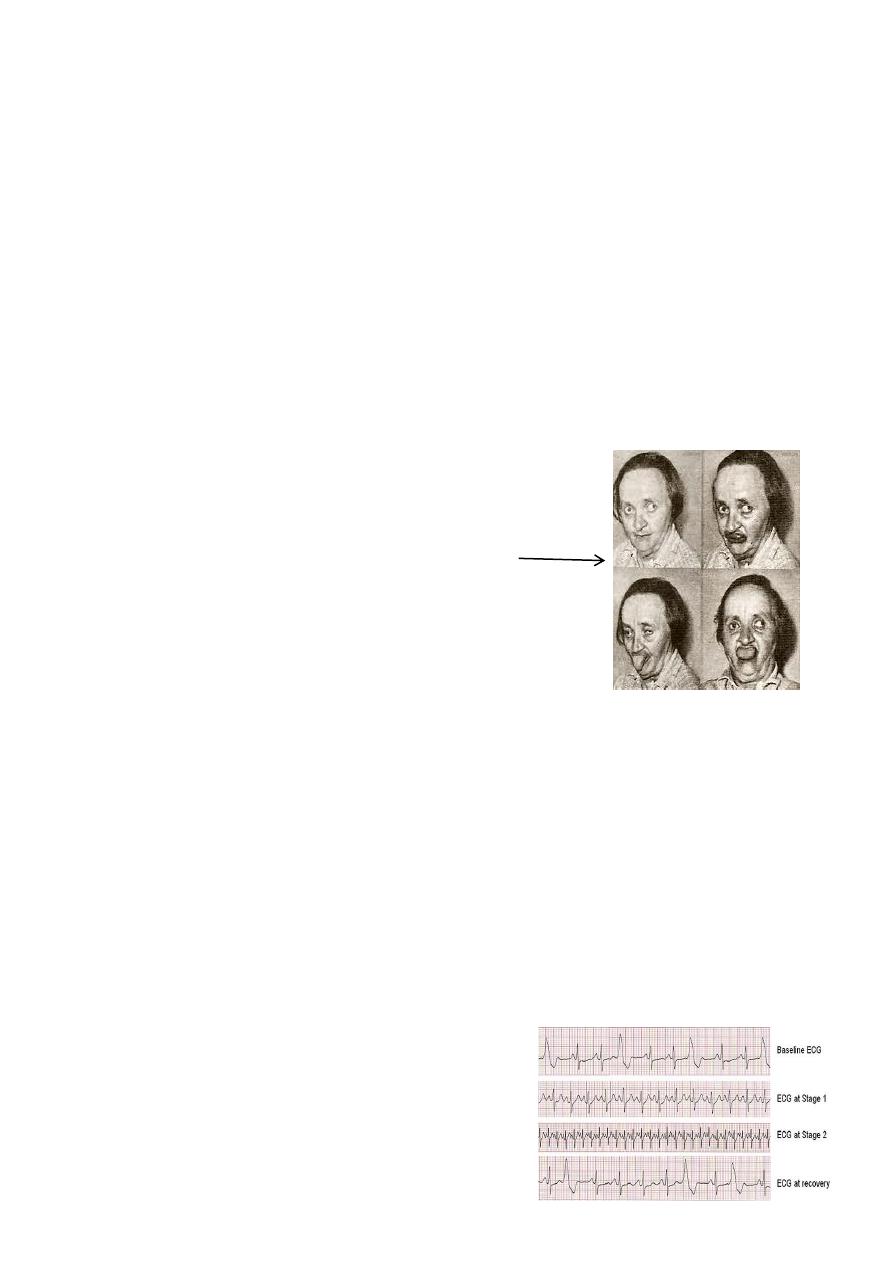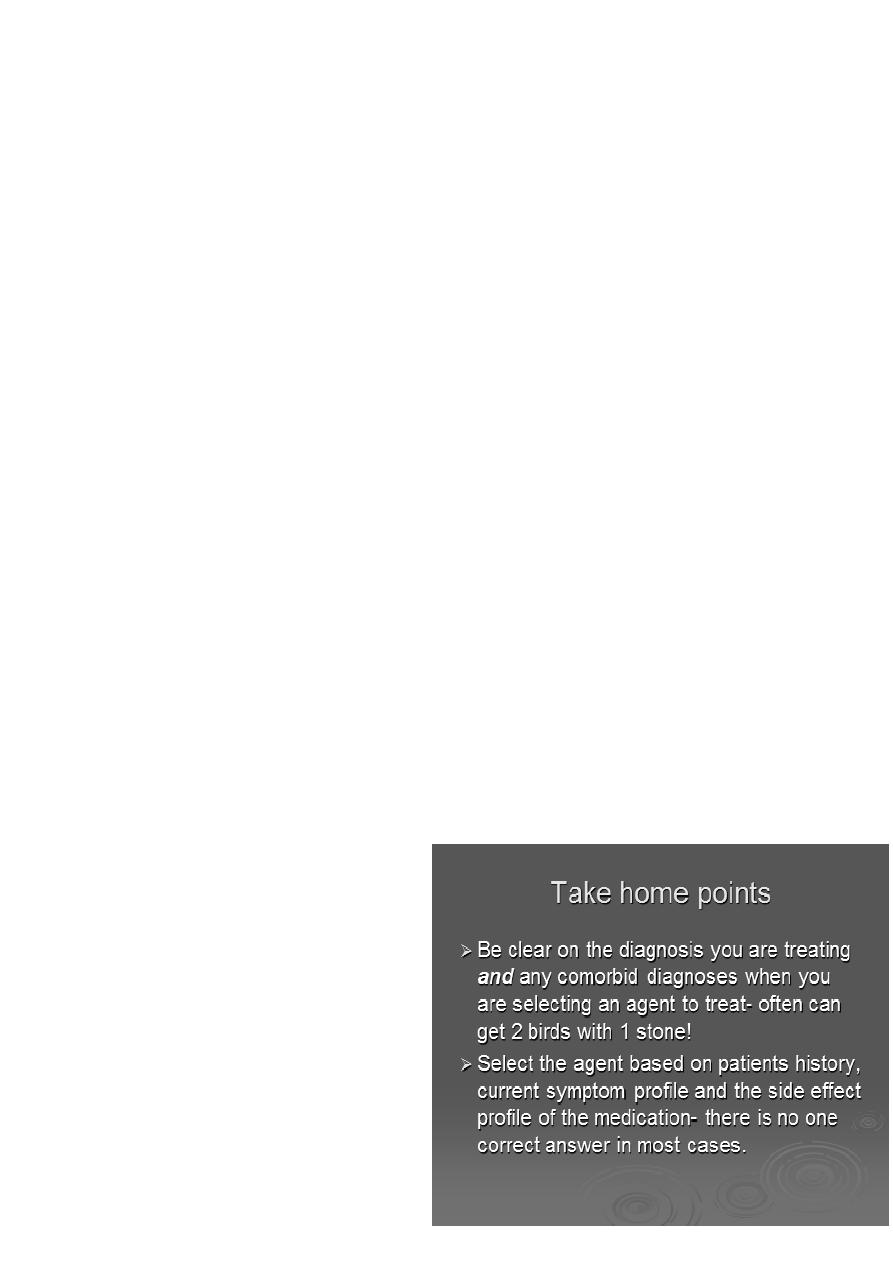
1
Fifth stage
Psychiatry
Lec-3
د
.
الهام الجماس
5/10/2015
Psychotropic drugs
Psychotropic drugs
Treat mood, cognition, and behavioral disturbances associated with psychological disorders
Most are not used recreationally or abused; Benzodiazepines are the exception
General classes of disorders
Mood
Anxiety
Psychotic
Other Disorders
Attention Deficit Disorder
Depression
Depression is a serious disorder that afflicts approximately 14 million adults in the United
States each year. The lifetime prevalence rate of depression in the United States has been
estimated to include 16 percent of adults (21 percent of women, 13 percent of men), or
more than 32 million people
Antidepressants
Indications:
Unipolar and bipolar depression,
organic mood disorders,
schizoaffective disorder,
anxiety disorders including OCD, panic, social phobia, PTSD,
premenstrual dysphoric disorder
impulsivity associated with personality disorders.
General guidelines
Antidepressant efficacy is similar so selection is based on past history of a response, side
effect profile and coexisting medical conditions.
There is a delay typically of 3-6 weeks after a therapeutic dose is achieved before symptoms
improve.

2
If no improvement is seen after a trial of adequate length (at least 2 months) and adequate
dose, either switch to another antidepressant or augment with another agent.
Mood disorders/Antidepressants
MAO Inhibitors
Tricyclics
Selective Serotonin Reuptake Inhibitors
Dual Action Antidepressants
Selective Norepinephrine Reuptake Inhibitors
Atypical antidepressant
MAOI
Use in late 1950s & ended in early 1960s
use ended due to side effect (death)
MAO breaks down many chemicals including tyramine
Tyramine is present in cheeses, red wines, alcohol, smoked fish
MAO in liver breaks down tyramine; Causes a hypertensive crisis "cheese syndrome"
increased blood pressure ➔ stroke ➔ death
increased heart rate ➔ heart attack ➔ death
Bind irreversibly to monoamine oxidase thereby preventing inactivation of biogenic amines
such as norepinephrine, dopamine and serotonin leading to increased synaptic levels.
They are very effective for depression
Side effects include orthostatic hypotension, weight gain, dry mouth, sedation, sexual
dysfunction and sleep disturbance
Hypertensive crisis can develop when MAOI’s are taken with tyramine-rich foods or
sympathomimetics.
Serotonin Syndrome can develop if take MAOI with meds that increase serotonin or have
sympathomimetic actions. Serotonin syndrome sx include abdominal pain, diarrhea,
sweats, tachycardia, HTN, myoclonus, irritability, delirium. Can lead to hyperpyrexia,
cardiovascular shock and death.
To avoid need to wait 2 weeks before switching from an SSRI to an MAOI. The exception of
fluoxetine where need to wait 5 weeks because of long half-life.
Mood Stabilizers (Antimanic
Agents)
LithiumCarbonate
Valproic Acid
Carbamazepine
Lamotragine
Topirimate

3
Tricyclic antidepressants
Act as agonists to catecholamines
No "cheese syndrome"
Side effects are the major problem
Cardiotoxic
Sedative action
Block acetylcholine system, especially muscarinic receptors
blurred vision, dry mouth, urinary retention, constipation, mental confusion
Block histamine receptors - sedation
Precaution
Very effective but potentially unacceptable side effect profile i.e. antihistaminic,
anticholinergic, antiadrenergic
Lethal in overdose (even a one week supply can be lethal!)
Can cause QT lengthening even at a therapeutic serum level
TCA
Have tertiary amine side chains
Side chains are prone to cross react with other types of receptors which leads to more side
effects including antihistaminic (sedation and weight gain), anticholinergic (dry mouth, dry
eyes, constipation, memory deficits and potentially delirium), antiadrenergic (orthostatic
hypotension, sedation, sexual dysfunction)
Act predominantly on serotonin receptors
Examples:Imipramine, amitriptyline, doxepin, clomipramine
Selective serotonin reuptake inhibitors
SSRI
Selectively block re-uptake of 5-HT
Work on DA and NE as well but very little
Eliminate ACh and antihistamine effects
No more effective than MAOIs or tricyclics
Better because there are fewer side effects
On market since late 1980s & early 1990s
Fluoxetine – Prozac

4
Sertraline - Zoloft
Paroxetine - Paxil
Fluvoxamine - Luvo
Citalopram - Celexa
Escitalopram - Lexapro
Block the presynaptic serotonin reuptake
Treat both anxiety and depressive
Most common side effects include GI upset, sexual dysfunction (30%+!), anxiety,
restlessness, nervousness, insomnia, fatigue or sedation, dizziness
Very little risk of cardiotoxicity in overdose
Can develop a discontinuation syndrome with agitation, nausea, disequilibrium and
dysphoria
SNRI
Selectively inhibits NE transporter.
Blocks re-uptake.
Atomoxetine (Strattera)
Reboxetine (Edronax, Vestra)
Dual action AD
Affinity for both 5-HT and NE.
Block re-uptake for both
In this sense, like TCAs
Duloxetine - Cymbalta
Atypical Antidepressants
The atypical antidepressants are a mixed group of agents that have actions at several
different sites. This group includes bupropion; mirtazapine; nefazodone, and trazodone
Bupropion (Wellbutrin)
No effect on either 5-HT or NE
Effective at blocking DA reuptake
May be similar action to cocaine
Lowers seizure threshold

5
Venlafaxine (Effexor)
5-HT, DA and NE reuptake blocker
Drugs for bipolar
Treat the manic phases of Bipolar Disorder
Lithium
Valproic Acid
Carbamazepine/Oxcarbazepine
Lamotragine
Topirimate
Symbyax – Combo of olanzepine and fluoxetine (Zyprexa & Prozac)
Mood Stabilizers
Indications: Bipolar, cyclothymia, schizoaffective, impulse control and intermittent
explosive disorders.
Classes: Lithium, anticonvulsants, antipsychotics
Which you select depends on what you are treating and again the side effect profile.
Lithium
Only medication to reduce suicide rate.
Rate of completed suicide in BAD ~15%
Effective in long-term prophylaxis of both mania and depressive episodes in 70+% of
BAD I pts
Factors predicting positive response to lithium
Prior long-term response or family member with good response
Classic pure mania
Mania is followed by depression
Before starting :Get baseline creatinine, TSH and CBC. In women check a pregnancy test-
during the first trimester is associated with Ebstein’s anomaly 1/1000 (20X greater risk than
the general population)
Monitoring: Steady state achieved after 5 days- check 12 hours after last dose. Once stable
check q 3 months and TSH and creatinine q 6 months.
Goal: blood level between 0.6-1.2mmol /lit

6
Lithium side effects
Most common are GI distress including reduced appetite, nausea/vomiting, diarrhea
Thyroid abnormalities
Non significant leukocytosis
Polyuria/polydypsia secondary to ADH antagonism. In a small number of patients can
cause interstitial renal fibrosis.
Hair loss, acne
Reduces seizure threshold, cognitive slowing, intention tremor
Lithium toxicity
Mild- levels 1.5-2.0 see vomiting, diarrhea, ataxia, dizziness, slurred speech, nystagmus.
Moderate-2.0-2.5 nausea, vomiting, anorexia, blurred vision, clonic limb movements,
convulsions, delirium, syncope
Severe- >2.5 generalized convulsions, oliguria and renal failure
Study Questions
Choose the ONE best answer.
12.1 A 55-year-old teacher began to experience changes in mood. He was losing interest in
his work and lacked the desire to play his daily tennis match. He was preoccupied with
feelings of guilt, worthlessness, and hopelessness. In addition to the psychiatric symptoms,
the patient complained of muscle aches throughout his body. Physical and laboratory tests
were unremarkable. After 6 weeks of therapy with fluoxetine, the patient's symptoms
resolved. However, the patient complains of sexual dysfunction. Which of the following
drugs might be useful in this patient?
A. Fluvoxamine.
B. Sertraline.
C. Citalopram.
D. Mirtazapine.
E. Lithium.
Correct answer = D. Sexual dysfunction commonly occurs with TCAs, SSRIs, and SNRIs.
Mirtazapine is largely free from sexual side effects.
A 25-year-old woman has a long history of depressive symptoms accompanied by body
aches. Physical and laboratory tests are unremarkable. Which of the following drugs might
be useful in this patient?

7
A. Fluoxetine.
B. Sertraline.
C. Phenelzine.
D. Mirtazapine.
E. Duloxetine.
Correct answer = E. Duloxetine is an SNRI that can be used for depression accompanied by
neuropathic pain. MAOs and SSRIs have little activity against neuropathic pain
A 51-year-old woman with symptoms of major depression also has narrow-angle glaucoma.
Which of the following antidepressants should be avoided in this patient?
A. Amitriptyline.
B. Sertraline.
C. Bupropion.
D. Mirtazepine.
E. Fluvoxamine.
Correct answer = A. Because of its potent antimuscarinic activity, amitriptyline should not
be given to patients with glaucoma because of the risk of acute increases in ocular
pressure. The other antidepressants all lack antagonist activity at the muscarinic receptor.
A 36-year-old man presents with symptoms of compulsive behavior. If anything is out of
order, he feels that “work will not be accomplished effectively or efficiently.― He
realizes that his behavior is interfering with his ability to accomplish his daily tasks but
cannot seem to stop himself. Which of the following drugs would be most helpful to this
patient?
A. Imipramine.
B. Fluvoxamine.
C. Amitriptyline.
D. Tranylcypromine.
E. Lithium.
Correct answer = B. Selective serotonin reuptake inhibitors are particularly effective in
treating obsessive-compulsive disorder; flu vox amine is approved for this condition. The
other drugs are ineffective in the treatment of obsessive-compulsive disorder.

8
Neuroleptics
Antipsychotics used to treat schizophrenia.
Schizophrenia is a severe chronic disorder
Positive symptoms: hallucinations, and delusions
Negative symptoms: amotivation, poverty of speech, flat affect
Disorganized symptoms: speech, thought, and behavior
Now being used to treat Bipolar as well
Antipsychotics
Indications for use:
schizophrenia, schizoaffective disorder, bipolar disorder- for mood stabilization
and/or when psychotic features are present, delirium,
psychotic depression,
dementia,
trichotillomania, augmenting agent in treatment resistant anxiety disorders.
Pathways affected by DA in the Brain

9
Antagonize dopamine – block a specific receptor
The Atypical Antipsychotics
- atypical agents are serotonin-dopamine 2 antagonists (SDAs)
They are considered atypical in the way they affect dopamine and serotonin
neurotransmission in the four key dopamine pathways in the brain.
Antipsychotics drugs (typical)
Group
drug
Usual dose
Phenothiazines
chlorpromazine
100-1500mg daily
Butyrophenones
haloperidol
5-30mg daily
50-100mg IMI monthly
5mg IMI o
rIVI
on need
Thioxanthenes
flupentixol
40-200mg fortnight
Short & long acting
Diphenylbutylpiperidines
Trifluperazine
Pimozide
stelazine
4-30mg daily
1,5,10mg orally
Substituated benzamides
Fluphenazine decanoate
Sulpiride
Modecate
600-1800mg daily
25 mg IMI monthly
Neuroleptics
. The traditional or typical neuroleptic drugs (also called conventional or first-generation
antipsychotics) are competitive inhibitors at a variety of receptors, but their antipsychotic
effects reflect competitive blocking of dopamine receptors. These drugs vary in potency.
For example, chlorpromazine is a low-potency drug, and fluphenazine is a high-potency
agent No one drug is clinically more effective than another.
Typical
Chlorpromazine
Trifluperazine Thorazine
Haloperidol – (Haldol)
Atypical
Risperdal - Risperidone
Olanzepine - Zyprexia
Quetiapine - Seroquel
Ziprasidone – Geodon
Aripiprazole – Abilify
Paliperidone – Invega

11
Atypical antipsychotic agent
Group
drugs
Usual dose
Dibenzodiazepine
clozapine
25-900mg daily
Bezisoxazole
Quetiapine -
Risperidone
Seroquel
2-16mg daily
100-200mg/d
Thienobenzodiazepine
olanzapine
5-20mg daily
Atypical
atypical agents are serotonin-dopamine 2 antagonists (SDAs)
They are considered atypical in the way they affect dopamine and serotonin
neurotransmission in the four key dopamine pathways in the brain.
Mechanism of action
Dopamine receptor blocking activity in the brain:. D
1
and D
5
receptors activate adenylyl
cyclase, often exciting neurons, whereas D
2
, D
3
and D
4
receptors inhibit adenylyl cyclase, or
mediate membrane K
+
channel opening leading to neuronal hyperpolarization. The
neuroleptic drugs bind to these receptors to varying degrees. However, the clinical efficacy
of the typical neuroleptic drugs correlates closely with their relative ability to block D
2
receptors in the mesolimbic system of the brain. atypical drug clozapine has higher
affinity for the D
4
receptor and lower affinity for the D
2
receptor, which may partially
explain its minimal ability to cause extrapyramidal side effects (EPS).
Serotonin receptor blocking activity in the brain: Most of the newer atypical agents appear
to exert part of their unique action through inhibition of serotonin receptors (5-HT),
particularly 5-HT
2A
receptors. (clozapine ,olanzapine,aripiprazole , Quetiapine ).
The undesirable side effects of these agents, however, are often a result of actions at
these other receptors:
Antipsychotic actions: All of the neuroleptic drugs can reduce the hallucinations and
delusions associated with schizophrenia
by blocking dopamine receptors in the mesolimbic system of the brain. The antipsychotic
effects usually take several days to weeks to occur, suggesting that the therapeutic effects
are related to secondary changes in the corticostriatal pathways.
Extrapyramidal effects: Dystonias (sustained contraction of muscles leading to twisting
distorted postures), parkinson-like symptoms, akathisia (motor restlessness), and tardive
dyskinesia (involuntary movements of the tongue, lips, neck, trunk, and limbs) occur with
chronic treatment. Blocking of dopamine receptors in the nigrostriatal pathway probably

11
causes these unwanted movement symptoms. The atypical neuroleptics exhibit a lower
incidence of these symptoms.
Antiemetic effects: With the exceptions of aripiprazole and thioridazine , most of the
neuroleptic drugs have antiemetic effects that are mediated by blocking D
2
-dopaminergic
receptors of the chemoreceptor trigger zone of the medulla.
Antimuscarinic effects: Some of the neuroleptics, particularly thioridazine, chlorpromazine,
clozapine, and olanzapine ,produce anticholinergic effects, including
blurred vision dry mouth (exception: clozapine increase salivation), confusion, and
inhibition of gastrointestinal and urinary tract smooth muscle, leading to constipation and
urinary retention. This anticholinergic property may actually assist in reducing the risk of
EPS with these agents.
Important side effects to be considered when choosing
antipsychotic drugs
1-Extrapyramidial side effects:
Atypical antipsychotic has less extrapyramidal effect.
2-hyperprolactinaemia: Lead to menstrual
disturbances,increased risk of malignancy,increased
galactorrhea,& increased osteoporosis.
Prolactine sparingis aripiprazole
3-sedation Increased sedation with high affinity to histamine& muscarinic receptors
CPZ,olanzapine,clozapine
Helpful in acute state
4-weight gain:
Histamine & 5HT R block
(>olanzapine)less with resperidone,amisulpride,&aripipraz 5.Type 11 DM
>clozapine &olanzapine
Should be monitored by Bd sugar,lipid profile& weight.
6-CV&
11
erebrovascular events ,
through their effect on the lipid profile ,Wt,& insulin
resistance. Some produce prolonge QT interval.
Olanzapine& resperidone
7-postural hypotension

12
8-sexual dysfunction
9-photosensitivity
10-agranulocytosis
11-constipation
12-reduction of fit threshold
Other effects: Blockade of -adrenergic receptors causes orthostatic hypotension and light-
headedness. The neuroleptics also alter temperature-regulating mechanisms and can
produce poikilothermia (body temperature varies with the environment). In the pituitary,
neuroleptics block D
2
receptors, leading to an increase in prolactin release. Atypical
neuroleptics are less likely to produce prolactin elevations. Sedation occurs with those
drugs that are potent antagonists of the H
1
-histamine receptor, including chlorpromazine,
olanzapine, quetiapine, and clozapine. Sexual dysfunction may also occur with the
antipsychotics due to various receptor-binding characteristics.
Therapeutic uses
Treatment of schizophrenia:
The neuroleptics are considered to be the only efficacious treatment for schizophrenia.
Prevention of severe nausea and vomiting: The older neuroleptics (most commonly
prochlorperazine) are useful in the treatment of drug-induced nausea
Other uses: The neuroleptic drugs can be used as tranquilizers to manage agitated
and disruptive behavior secondary to other disorders.
Neuroleptics are used in combination with narcotic analgesics for treatment of
chronic pain with severe anxiety
Chlorpromazine is used to treat intractable hiccups.
Promethazine, this agent is used in treating pruritus .
Pimozide is primarily indicated for treatment of the motor and phonic tics of
Tourette's disorder. risperidone and haloperidol are also commonly prescribed for
this tic disorder.
Also, risperidone is now approved for the management of disruptive behavior and
irritability secondary to autism
Photosensitivity

13
Antipsychotic adverse effect
Tardive Dyskinesia (TD)-involuntary muscle movements that may not resolve with
drug discontinuation- risk approx. 5% per year
Neuroleptic Malignant Syndrome (NMS): Characterized by severe muscle rigidity,
fever, altered mental status, autonomic instability, elevated WBC, CPK and lfts.
Potentially fatal.
Extrapyramidal side effects (EPS): Acute dystonia, Parkinson syndrome, Akathisia
Parkinson-like symptoms of bradykinesia, rigidity, and tremor usually occur within
weeks to months of initiating treatment. Clozapine can produce bone marrow
suppression, seizures, and cardiovascular side effects. The risk of severe
agranulocytosis necessitates frequent monitoring of white-blood-cell counts
The neuroleptics depress the hypothalamus, affecting thermoregulation, and causing
amenorrhea, galactorrhea, gynecomastia, infertility, and impotence. Significant
weight gain is often a reason for noncompliance. It is also recommended that glucose
and lipid profiles be monitored in patients taking antipsychotics
The choice of medication &dose :depend on
1-sevirety of the problems.
2-degree of sedation required.
3-side effect profile.
4-preferance of individual clinician.
Study Questions
Choose the ONE best answer.
13.1 An adolescent male is newly diagnosed with schizophrenia. Which of the following
neuroleptic agents may improve his apathy and blunted affect?
A. Chlorpromazine.
B. Fluphenazine.
C. Haloperidol.
D. Risperidone.
E. Thioridazine
Correct answer = D. Risperidone is the only neuroleptic on the list that has some benefit in
improving the negative symptoms of schizophrenia. All the agents have the potential to
diminish the hallucinations and delusional thought processes.

14
Which one of the following neuroleptics has been shown to be a partial agonist at the D
2
receptor?
A. Aripiprazole.
B. Clozapine.
C. Haloperidol.
D. Risperidone.
E. Thioridazine.
Correct answer = A. Aripiprazole is the agent that acts as a partial agonist at D
2
receptors.
Theoretically, the drug would enhance action at these receptors when there is a low
concentration of dopamine and would block the actions of high concentrations of
dopamine. All the other drugs are only antagonistic at D
2
receptors, with haloperidol
being particularly potent.
A 21-year-old male has recently begun pimozide therapy for Tourette's disorder. He is
brought to the emergency department by his parents. They describe that he has been
having “different-appearing tics― than before, such as prolonged contraction of the
facial muscles. While being examined, he experiences opisthotonus (spasm of the body
where the head and heels are bent backward and the body is bowed forward. A type of
extrapyramidal effect). Which of the following drugs would be beneficial in reducing these
symptoms?
A. Benztropine.
B. Bromocriptine.
C. Lithium.
D. Prochlorperazine.
E. Risperidone
Correct answer = A. The patient is experiencing extrapyramidal symptoms due to
pimozide, and a muscarinic antagonist such as benztropine would be effective in reducing
the symptoms. The other drugs would have no effect or, in the case of prochlorperazine,
might increase the symptoms.
A 28-year-old woman with schizoid affective disorder and difficulty sleeping would be most
benefited by which of the following drugs?
A. Aripiprazole.

15
B. Chlorpromazine.
C. Haloperidol.
D. Risperidone.
E. Ziprasidone.
Correct answer = B. Chlorpromazine has significant sedative activity as well as
antipsychotic properties. Of the choices, it is the drug most likely to alleviate this patient's
major complaints, including her insomnia
Anxiolytic
Treat anxiety disorders
Generalized Anxiety Disorder
Panic Disorder
PTSD
OCD
Social Anxiety Disorder (SAD)
Used to treat many diagnoses including panic disorder,
generalized Anxiety disorder,
substance-related disorders and their withdrawal,
insomnias and parasomnias.
In anxiety disorders often use anxiolytics in combination with SSRIS or SNRIs for treatment.
Benzodiazepines
Used to treat insomnia, parasomnias and anxiety disorders.
Often used for CNS depressant withdrawal
protocols ex. ETOH withdrawal.
Side effects/cons
Somnolence
Cognitive deficits
Amnesia
Disinhibition
Tolerance
Dependence

16
Monitor for efficacy and tolerance and adjust as indicated.
If the patient does not improve step back, rethink your diagnosis and treatment plan!
Keep an eye on drug-drug interactions
Benzodiazepines Facilitate GABA neurotransmission
Bind to a particular site on the GABA receptor
Xanax, Ativan, Valium, Serax, Librium
Beta-Blockers
Antagonize NE by blocking Beta receptor subtype
SSRIs
PTSD, OCD, SAD, and to some degree GAD
Others
Buspar
Non-sedating
Does not interact with alcohol
Not highly effective
ADD
Methylphenidate – Ritalin
DA reuptake inhibitor
So slowly it enters the brain that it is not addictive like cocaine even though they
have the same mechanism
Concerta (Immediate release combined with time release)
Adderal (mixed amphetamine salts)
Has extended release
Modafinil – Provigil
Vyvanse
An amphetamine pro-drug
Less abusable
Straterra

17
Mixing Med
.
Although classified as a certain type of drug most psych meds used for many different
disorders.
Antipsychotics in Bipolar Disorder
Abilify
Zyprexa
Mood stabilizers in alcoholism
Topiramate
Prescribing a medication for a disorder when it is known to work, but there is no formal
FDA indication is called “off-label prescribing”
It’s perfectly legal and quite common
